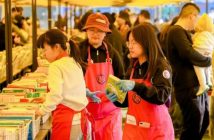
It’s August in Beijing; the city’s expat community has shed its departing families and welcomed a fresh batch. Whether you’re new to Beijing, or just returning from vacation, walking the city’s streets is a great way to acquaint, or reacquaint, yourself with the capital. We spotlight four walking itineraries across the ‘Jing selected by some of its best tour guides. Get out and explore before school starts! This part two of a four part series, find part one here and part two here.
Featured Guide: Phoebe Han (The Hutong)
Phoebe Han is originally from Xinjiang and has been The Hutong’s tea expert for three years. She also arranges and coordinates activities for the company. To book a tour with Han, visit The Hutong’s website at thehutong.com. For more information, email info@thehutong.com or call 159 0104 6127. The courtyard at located at 1 Jiudaowan Zhongxiang, Dongcheng District.
The Hutong’s tea tour incorporates a variety of tea shops, focusing on China’s diversity in tea production. From the oolongs of Fujian to the green teas of Anhui and Zhejiang and rich pu’er teas from Yunnan, Guide Phoebe Han regularly takes visitors through the maze that is Maliandao Tea Market.
“I want people to learn about tea so that later when they go to buy [it], they know what to look for in terms of taste and color,” says Han. “I hope that our guests come away with a deeper knowledge of China’s incredible tea culture.”
The day starts at Wanzi subway station (line 7, exit D). Walk south along Maliandao Lu for ten to 15 minutes until you get to Beijing Tea Head Office (Beijing chaye zong gongsi). Inside, there are hundreds of tea vendors.

This is where the tea tour starts in earnest. Head to shop 109 to try some green tea. Sample a variety and discuss their differences between each tea. Afterwards, Han might take visitors to shop 103 to try white tea.
Then there’s a break for lunch. The Hutong recommends Xiangfu Tianxia, a Hunan restaurant that also serves food from other provinces such as Beijing’s jingjiang rousi (shredded pork in sweet bean sauce).
After lunch, head to the tour’s main destination: Maliandao Tea Market, about a ten-minute walk east. While Beijing has a number of tea shops, many of which can trace their history back to the days of the Qing Emperors, Maliandao provides a unique opportunity to visit the wholesale merchants where they work and shop. Now the epicenter of tea culture and trade in Beijing, the area was nearly empty prior to 1996.

“When visitors first arrive at Maliandao, it can be overwhelming,” says Han. “We visit a variety of shops — different ones each time — to give the guests a broad idea of what tea they might like.” She points out that The Hutong never accepts money from merchants, so visitors can rest assured that vendors are chosen strictly for quality.
The Hutong usually takes visitors to try various oolong teas from mainland China, encouraging them to take the time to learn about each tea and share observations with others. The tastings vary for each visit, but the last variety is usually Chinese red tea or dark tea (also known as fermented tea).
Lastly, participants explore tea tools and furniture, which some vendors specialize in. They’ll find all kinds of exquisite teacups, tea chopsticks, and Yixing clay teapots, which are intended for black, oolong, and aged pu’er teas.
Stops
Beijing Tea Head Office Tea Market 北京茶叶总公司茶市场
Shiji Chamao Zhongxin, Courtyard 2, 1 Chama Beijie, Xicheng District 西城区茶马北街1号世纪茶贸中心
Xiangfu Tianxia 湘褔天下
Daily 11am-2.30pm, 5-9pm. Maojia Hotel (across from Qixiang Hotel), Bldg 1, 16 Maliandao Nanjie, Xicheng District (6346 8781) 西城马连道南街16号院1号楼毛家饭店(气象宾馆对面)
Maliandao Tea Market 马连道茶城
Daily 9am-7pm. 11 Maliandao Lu (near
Carrefour), Xicheng District (6343 8550) 西城区马连道路11号(近家乐福)
This article originally appeared on page 60-61 of the beijingkids August 2015 issue. Click here to read the issue for free on Issuu.com. To find out how you can get your own copy, email distribution@truerun.com.
Photos: Courtesy of The Hutong



